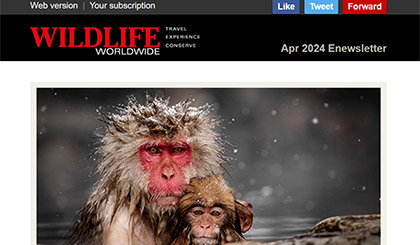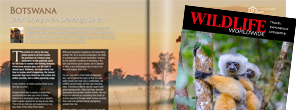Gearing up for Wildlife Photography

With Wildlife Worldwide’s tours giving you some incredible opportunities to see wildlife in the field, you're certainly going to want to make the most of the photographic opportunities. In order to capture these moments, having the right camera gear is an essential consideration, so below is my guide to help you select the best tools for bringing home some impressive images from your next wildlife adventure. I have started with the essentials here and will move on to accessories in the next instalment.
Essentials
The essentials are well… just that, the key components to any wildlife photographer’s bag. These are the bits of gear that get the job done and are perfect for capturing your encounters with wildlife when on tour.
Camera
It goes without saying that you’ll need a camera. For most people who want to get more serious about their photography, a DSLR is the place to start. They offer the best in terms of performance, customisation and options, allowing you fast access to key features as well as manual control for those artistic wildlife images. Most modern DSLR cameras are capable of taking excellent images, even the lowest spec. models, but for wildlife photography, looking for a camera with a more advanced autofocus system, frame rate and ISO performance, will help you make the most of any sightings, from getting locked on, to capturing action even when the light starts to fade.
 Full frame cameras offer the best in image quality, but are more expensive. APS-c cameras, on the other hand, have their advantages too. With a higher crop factor for greater magnification, your lenses are effectively longer. When choosing a camera be sure to try and test it “in the hand” at your local camera store to get a better feel for how comfortable it is. As you’ll be spending a long time holding it, it’s a good idea to get the right fit. In terms of brands, Nikon and Canon are that largest players in the DSLR market and also offer the best all-round systems to buy into, but Sony are certainly making waves with their mirrorless designs that offer more lightweight solutions. If you are budgeting for both a camera and a lens, spend more on the lens as better optics allow for finer rendering and light transmission, which ultimately give better looking images.
Full frame cameras offer the best in image quality, but are more expensive. APS-c cameras, on the other hand, have their advantages too. With a higher crop factor for greater magnification, your lenses are effectively longer. When choosing a camera be sure to try and test it “in the hand” at your local camera store to get a better feel for how comfortable it is. As you’ll be spending a long time holding it, it’s a good idea to get the right fit. In terms of brands, Nikon and Canon are that largest players in the DSLR market and also offer the best all-round systems to buy into, but Sony are certainly making waves with their mirrorless designs that offer more lightweight solutions. If you are budgeting for both a camera and a lens, spend more on the lens as better optics allow for finer rendering and light transmission, which ultimately give better looking images.
Camera-wise, I personally shoot with a Nikon D500 and a D810. These are top spec. cameras and work fantastically professionally. Remember there is no perfect camera for everyone, so look for the features above and then nail it down by budget to find a model that suits your needs. If you are going on a big trip, think about buying or borrowing an extra body to take along. Having a spare camera is always important as if anything failed on your primary, not being able to capture any memories for the rest of the trip would be truly devastating!
Lenses
When capturing wildlife with a DSLR, most of the time you will be after a telephoto lens to get closer to the action and pinpoint your subjects, isolating them for portrait or action shots. For most subjects (depending on their size and how close you can get) you’ll want something of around 300 mm or above to capture the action. These lenses will allow you to stay at a respectable distance, whilst framing in close to capture your subject.
An excellent go-to lens for the safari or wildlife tour is the 80-400 mm focal range, offering the scope to capture everything from detailed portraits to “in the landscape” images. The single lens means you won’t have to switch lenses continually, helping you to make the most of any encounters. Personally I found the 80-400 mm excellent on my trip to Canada last summer, working from boats around Vancouver Island it was possible for me to get a range of images, whilst shooting from a moving Zodiac. Paired with a cropped factor body, the range was extended to 120-600 mm, giving amazing scope for wildlife work.

With a long lens in the bag, it’s also important to capture the environment, so having a wide angle can be great for scenery, as well as when the moments present themselves for more “wildlife in the landscape” images. Wide is known as anything below normal or the 50 mm focal length. It can be tempting to jump straight to the 16 mm super wide focal length, but in many situations these ultra wides can look unnatural and are hard to work with to create great results. Often a more normal length such as a 24-70 can offer more in terms of flexibility and usability for a range of photo assignments. With 24-70 mm lenses also being available in the f2.8 aperture, they are excellent performers in low light. Certainly one of my favourite lenses for creating landscapes and travel images when I’m out on location, and one that was permanently attached to one of my bodies when I was in Canada. Of course the 24-70 and 80-400 combination together gives excellent coverage for capturing everything from landscapes through to small birds.
One extra type of lens to look into if insects and flowers are your thing, is that of the macro. Allowing you to get ultra close to your subject and magnify tiny critters, these are wonderful for seeing the unique beauty of plants and exploring the botanical elements in the landscape. If bugs and flowers are your thing, then certainly think macro!
Essential accessories
Of course to go with your camera there are a few things you certainly need to pick up and the most essential two of all are spare batteries and memory cards!
 Be sure to pick up AT LEAST two spare batteries for your camera in order to make sure you don’t run out of juice at those critical moments. Personally I’d recommend one of these being an own brand model - they are more expensive but are of proven quality. Bring a fast charger as well to help refill in the evenings. Regarding memory, be sure to have enough cards for the full duration of your shoot and then buy a couple of extras just in case. I never want to have to delete images while I'm away. Cards are far cheaper these days, so if in doubt, buy a couple of extras because they always find a way to be useful!
Be sure to pick up AT LEAST two spare batteries for your camera in order to make sure you don’t run out of juice at those critical moments. Personally I’d recommend one of these being an own brand model - they are more expensive but are of proven quality. Bring a fast charger as well to help refill in the evenings. Regarding memory, be sure to have enough cards for the full duration of your shoot and then buy a couple of extras just in case. I never want to have to delete images while I'm away. Cards are far cheaper these days, so if in doubt, buy a couple of extras because they always find a way to be useful!
That about covers it for Part One of gearing up for your next wildlife photography adventure!
In the next instalment, Tom covers a few of the other accessories you’ll want to think about adding to your photographic gear. In the meantime, check out Tom's Top 10 Tips for Wildlife Photography.








